穴窯(あながま)
日本では江戸初期(1600年ころ)に、登り窯が導入されるまで使われていた燃焼室と作品スペースが分かれていない、単室の窯です。
焚き口から薪をくべ続け、温度を上げて行く窯です。
構造はトンネル状の単純なものですので、
窯詰めの方法が大変重要になるのが特徴です。
この窯に釉薬を掛けずに窯詰めをして、4昼夜から5昼夜を掛けて薪をくべ続けて焼き上げます。
無釉薬で土を焼くので「焼締(やきしめ)」とも呼ばれます。
Anagama
In Japan, in the early Edo period (Around 1600 AD), it is a single room kiln where the work spaces were not divided until the climbing kiln was introduced.
It is a kiln that continues to feed firewood from the front stoke and raises the temperature.
The ANAGAMA is a simple structure with tunnel shape,
The method of loading the kiln is very important.
Fill the ANAGAMA with no glaze, and bake it from four days and nights five days and nights.
Because clay is fired with no glaze, it is also called "YAKISHIME". |
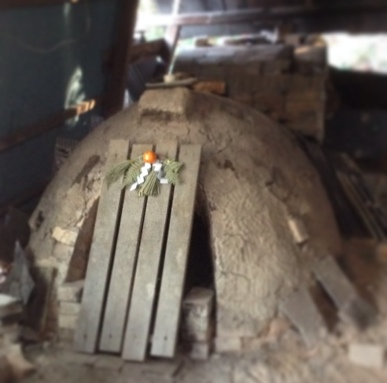 |
薪作り |
燃料は主に松を使用しています。
原木の状態で調達してチェンソーで一定の長さに切りそろえ
薪割りします。
The fuel of the ANAGAMA is mainly pine trees.
I can trim it to a certain length with a chain saw.
After that we will split the wood.
|
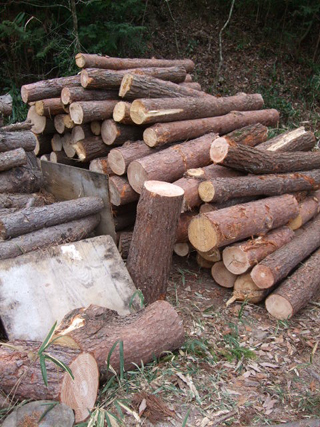
|
松の原木を割った状態。
The pine tree is broken. |
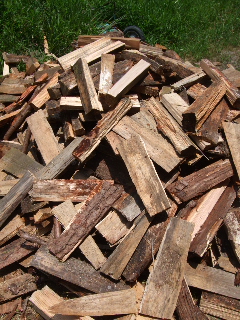 |
松を薪棚に並べて乾燥させます。
燃料として使えるまでに半年ほど枯らせます。
Align the pine on a wooden shelf and dry it.
It will dry for about half a year before it can be used as fuel. |
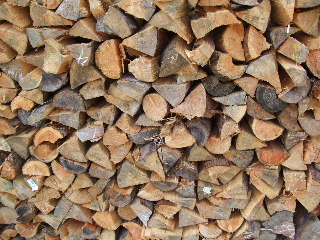 |
穴窯の窯焚き |
窯焚きです。
穴窯の窯詰めは窯の中に潜り込んで行います。
天井が低いのでかがんだ状態で窯詰めをします。
焚き口を正面に一つ残して、
そこから薪を放り込み窯焚き開始。
It is kiln fired.
The kiln loading of the Anagama is carried out by getting into the kiln.
Because the ceiling is low,
Leave one firing opening in front,
I threw firewood there and started kiln firing.
|
 |
温度が上がりにくい時には「口がけ」
または「木ブタ」とよばれる方法で、
焚き口一杯に薪を詰めます。
これにより、燃料の松薪の灰が炎にのってうつわに付着して行きます。
When the temperature is difficult to rise, fire the firewood and stack it in the mouth and fire the kiln.
This is a method called "KIBUTA".
As a result of this, the ash of the fuel pine wood flies in flames and adheres to the vessel. |
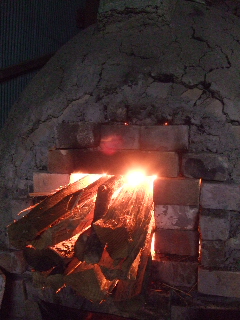 |
どんどんと窯内の温度が上がってくると、
燃料の松薪の灰が付着したものが熱で溶け
「ビードロ」と呼ばれる釉状のものに変化していきます。
As the temperature inside the kiln steadily rises,
Ash of fuel sticks a lot to the vessel.
It melts with heat
It changes to a glaze-like one called "BEEDRO". |
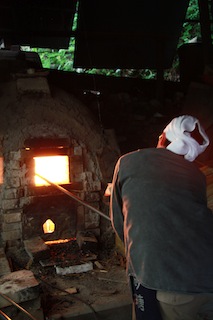 |
窯焚きの終盤には「引出(ひきだし)」と呼ばれる作業をすることがあります。
引出とは窯を焚いている最中に、
鉄棒を使ってうつわをまさに「ひっぱりだす」ことです。
窯を焚いている最中に作品を引出し、
急冷する事によって作品は独特の景色を呈します。
At the end of the kiln burning there is a work called "HIKIDASHI".
"HIKIDASHI" means that while burning a kiln,
It is to "pull out" the vessel from the kiln using a steel bar.
Withdrawing goods while firing the kiln,
By quenching, the vessel has a unique landscape.
|
 |
引き出されたばかりの花入。
熱で光っています。
A vessel taken out of the kiln.
It is shining with heat.
|
 |
引出ぐい呑(口部分)
熱で溶け釉状になった、燃料の松薪の灰
「ビードロ」の色。
HIKIDASHI GUINOMI (mouth part)
It was melted with heat, turned glazed, the fuel pine wood ash
The color of "Bidoro". |
 |
目標の温度まで薪を投げ
窯焚きも終盤へ。
Continue burning the kiln to the target temperature
Kiln firing also to the final stage. |
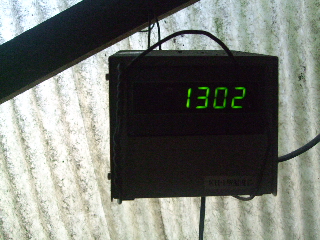 |
窯焚きが終わるとレンガと粘土で隙間の無いよう、
しっかりと目止めをします。
When the kiln firing is over, there seems to be no gap between the brick and the clay,
Fill tightly the gap. |
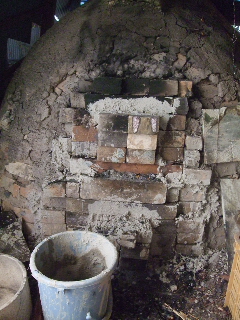 |
| 窯出し |
窯出しが終わってから数日間。
窯が冷めるのを待ちます。
中に入れる温度になったら窯出しです。
A few days after the kiln disposal has ended.
I will wait for the kiln to cool down.
I will put the kiln out when it comes to temperature.
|
 |
窯から出たばかりの作品たち。
A plate just out of the kiln. |
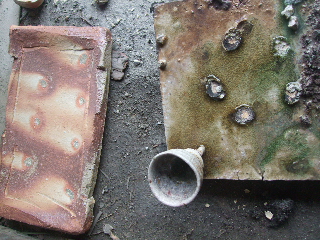 |
| |
穴窯によってさまざまな景色を得た信楽大壺
Shigaraki large vase with various views by ANAGAMA.
|
 |
